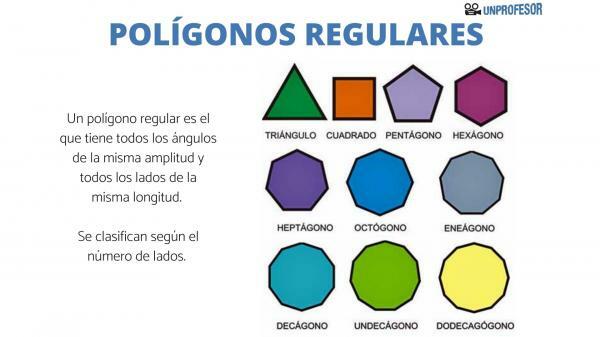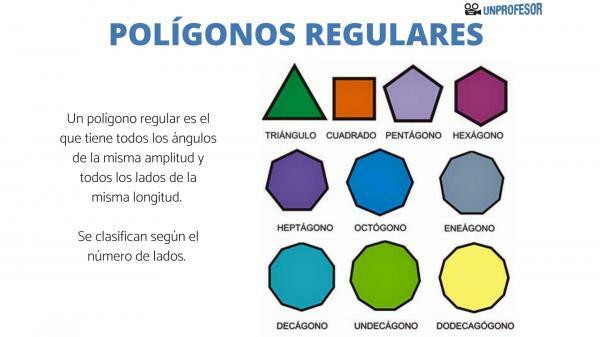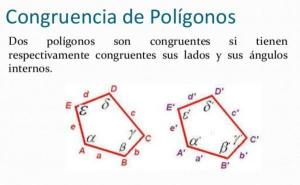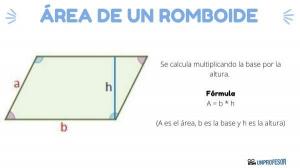Regular POLYGONS: names and classification

In this lesson from a Teacher we are going to talk about names of regular polygons and classification what we make of them, so it will be a rather theoretical article. First of all, we will clarify what we mean by a regular polygon. Next, we will make a classification of regular polygons. Finally, we will make a small exercise of which we will give you the solutions below.
A polygon is a figure that we draw in plane geometry that has a series of sides certain that include a region of a determined plane, that is to say, not infinite. The sides are the segments of the figure and the place where they join each other are the vertices Or, more commonly said, the corners. At each vertex a pair of angles, which is the amplitude that is generated inside that vertex and outside.
A regular polygon is the one that has all the áangles of the same amplitude and all the sides of the same length, otherwise it would become an irregular polygon. We can inscribe regular polygons within a circle and all the vertices will touch the edges of that circle, that is, they will touch the circumference. We can say the same in reverse: within regular polygons we can draw a circle, which will touch just in the middle of each side. In addition, this type of polygons have the same number of lines of symmetry as sides.
There are infinite regular polygons, starting from the one with three sides and three angles. Actually, when a regular polygon has infinite sides, it would tend to become a circle.
We are going to discover the classification of regular polygons and their names. This classification is done according to the number of sides and angles; are classified as follows:
- Equilateral triangle: has 3 sides and 3 angles of 60º each
- Square: it has 4 sides and 4 angles of 90º each. It is the only quadrilateral that is regular, remember that there are other quadrilaterals, but they are all irregular, such as the rectangle.
- Regular pentagon: it has 5 sides and 5 angles of 108º each.
- Regular hexagon: it has 6 sides and 6 angles of 120º each.
- Regular heptagon: it has 7 sides and 7 angles of 128.571º each.
- Regular octagon: it has 8 sides and 8 angles of 135º each.
- Regular enegon: it has 9 sides and 9 angles of 140º each.
- Regular decagon: has 10 sides and 10 angles of 144º each.
- Regular Endecagon: it has 11 sides and 11 angles of 147.27º each.
- Regular dodecagon: it has 12 sides and 12 angles of 150º each.
- Regular tridecagon: it has 13 sides and 13 angles of 152º each.
- Regular tetradecagon: it has 14 sides and 14 angles of 154.286º each.
- ...
As you have seen, only the first two (equilateral triangle and square) have their own name, because the others have simply taken the name of the figure with those sides and we add the word "regular" to them. behind.
If you need to learn the names of regular polygons by heart, we recommend that you write the names and the number of sides and angles on different cards and play tag. memory with your family or friends.

To finish this lesson and see if you have really learned the names of regular polygons and their classification, here are some training that will help you.
1. Relate the name of the polygon with its number of sides and angles:
- 3 regular pentagon
- 4 regular octagon
- 5 regular decagon
- 6 regular hendecagon
- 7 regular heptagon
- 8 regular tetradecagon
- 9 regular dodecagon
- 10 equilateral triangle
- 11 regular hexagon
- 12 regular enegon
- 13 regular tridecagon
- 14 square
Let's see if you have been able to identify each regular polygon with its number of sides and angles. Here we leave you the solutions from the previous exercise:
- Equilateral triangle: 3.
- Square: 4.
- Regular Pentagon: 5.
- Regular hexagon: 6.
- Regular heptagon: 7.
- Regular octagon: 8.
- Regular enegon: 9.
- Regular decagon: 10.
- Regular Endecagon: 11.
- Regular dodecagon: 12.
- Regular tridecagon: 13.
- Regular tetradecagon: 14.
Surely now you have much clearer what are regular polygons and what are there. If you want to expand your knowledge in Geometry and, specifically, on the issue of polygonsWe encourage you to investigate the tabs on our website, where you will find articles and videos that may be useful to you.



